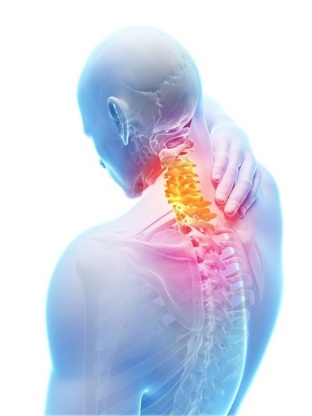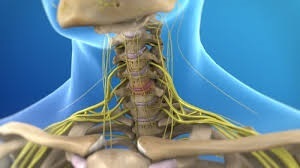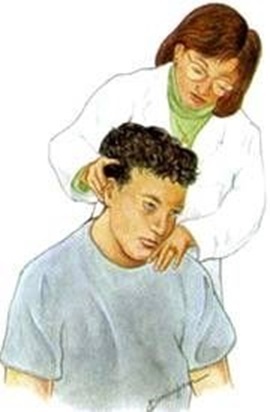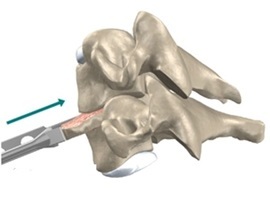Degenerative disc disease (low back pain) the cervical spine is the ultimate cause of pain symptoms in the neck and radiates to the pain in his hands. The pain symptoms start to occur when one or more intervertebral discs in the cervical spine begin to collapse because of degeneration.
The tendency of some people to develop osteoarthritis may have a genetic component. Trauma can also accelerate, and sometimes cause the development of degenerative changes in the cervical spine.
For the treatment of degenerative disc disease of the cervical spine gives good results only when it is a regular brand, and it is consistent and systematic. Osteochondrosis of the cervical spine is included in the list of the most common causes of symptoms in patients of working age, who are sitting long at the computer. Often patients do not pay attention to the pain and not seek medical help , which leads to complications.
Risk factors for degenerative disc disease of the cervical spine

Although almost all people sooner or later develop involutional degenerative changes in the cervical spine, there are some factors that may make more likely the early development of degenerative disc disease or symptoms. These risk factors can be:
- Genetics. Some studies of twins indicate that genetics plays a greater role than lifestyle, with the early development of degenerative disc disease of the cervical spine, and the rapid onset of symptoms.
- Obesity. The weight associated with the risk of development of degenerative disc disease (osteoarthritis).
- Smoking. This way can block the flow of nutrients to the discs and accelerate their hydration.
- In addition, spinal cord injuries can sometimes start or speed up the process of degeneration of the cervical spine.
Symptoms
Symptoms of degenerative disc disease of the cervical spine can vary greatly in different people.
When degenerative disc disease becomes symptomatic, pain may develop gradually or appear suddenly. Symptoms may vary some neck discomfort to debilitating serious pain radiates in the arm, numbness and / or muscle weakness.
The main symptoms:
- Pain in the neck. Low-intensity pain on a background of stiffness of the neck is the most common symptom of degenerative disc disease of the cervical spine. However, sometimes the pain can sharply increase and last for several hours or days.
- Neuralgia. This type of pain is usually sharp or shock radiating to the shoulder arm, hand and / or fingers. Typically, the neuralgia is felt only on one side of the body.
- Neurological symptoms of the hand, wrist and / or fingers. You may experience sensations, tingling, needles, numbness and / or weakness, which can extend along the entire upper limb. Such symptoms can interfere with everyday activities, for example, print, dress up or hold objects.
- Pain increases with movement. Usually pain caused by degenerative disc usually increases with movement and decreases with rest.
- If the pain comes from degenerative disc, it is likely to disappear spontaneously a few weeks or months. However, other symptoms of degenerative disc disease of the cervical spine often become chronic and require treatment, for example, if the facet joints in the neck also began to degenerate and / or compression of the nerve root.
Less common symptoms
More cervical spine degenerate, the more likely that the spinal canal narrowing and increase the risk of spinal cord compression. If there is spinal cord compression is to develop myelopathy and views symptoms, such as:
- Difficulty moving arms and / or legs
- Problems with coordination and / or balance
- Loss of control of bowel and / or bladder
- Weakness and / or numbness anywhere below the neck
- Shooting pains in the extremities, which can increase when you lean forward
Cervical myelopathy is a serious condition that requires immediate medical attention. Typically, this condition occurs in people over 50 years.
Diagnosis
The diagnosis of osteochondrosis of the cervical spine can be set on the basis of these data:
- Medical history. First, the physician has to examine in detail the symptoms and medical history.
- A physical inspection. Then the doctor will perform a physical examination, by sensing the neck and check the range of motion in the neck. During testing, patients can be asked to perform certain movements and showing more or reduce pain in the neck.
- If the pain is intense or if there is neurological symptoms, such as pain, tingling, or weakness in the shoulder, arm or hand, then the doctor is likely to prescribe medical imaging .
- Medical imaging (x-ray, CT, MRI, PET). If the doctor finds that to determine the exact origin of the symptoms, it is necessary to obtain an image of tissue (disks) then most likely designed for the MK. MRI, x-ray or perhaps CT scan can confirm whether there are signs of degeneration, and to identify other conditions (such as osteoarthritis or stenosis), which can cause symptoms.
- After confirmation of accurate diagnosis of degenerative disc disease of the cervical spine, as well as any other bound States, one can understand the Genesis of symptoms and to identify effective treatment programs.
Condition associated with degenerative disc disease of the cervical spine

Degeneration of disc is often associated with other pathological conditions that develop either at the same time, or in some cases, the cause of the other. Most often meets the following conditions:
- Hernia of the cervical spine happens in the case that disc degeneration leads to disruption of the integrity of the fibrous ring and protrusion of the content happens outside the ring. But a herniated disc may occur after injury , which ultimately accelerate the disc degeneration leads to the development of degenerative disc disease of the cervical spine .
- Cervical osteoarthritis. As soon as the disc degenerates and the disc space of the spine began to decline, the facet joints can begin to move abnormally and cause excessive wear on the cartilage and contribute to the formation of osteophytes of the cervical spine.
- Cervical stenosis of the spine. This condition, which happens due to osteophytes or herniated disc and is narrowing of the spinal canal (where the spinal cord) or foraminal foramen (where the nerve root).
But you have to understand that sometimes some people are born with a narrowing of the spinal canal and the development of symptoms associated with degenerative disc disease.
Cervical radiculopathy - symptoms of pain, tingling, numbness and / or weakness radiating to the shoulder, hand and arm can occur when one or more nerve roots are irritated or zaselyalsya. If stenosis happens when the spinal cord compression-disc herniation or osteophytes, that can develop myelopathy. Possible symptoms of pain, tingling, numbness and / or weakness can be felt at the level of the neck and anywhere below the level of compression. For example, a person may be a tingling or weakness in the legs, problems with balance or even difficulty in controlling bowel and bladder.
If you have symptoms of myelopathy, it is important to seek medical help because the condition can proceed, and without treatment can eventually develop paralysis of the limbs, and dysfunction.
Treatment
As a rule, when symptoms due to degenerative disc disease of the cervical spine to take curative measures with the aim to reduce the symptoms. Primarily in the treatment of degenerative disc disease of the cervical spine using non-surgical methods of treatment.

In rare cases, when pain and symptoms persist or worsen despite several months of treatment, or if there is a risk of damage to the spinal cord, then the question of action.
Options for conservative treatment
The treatment of neck pain caused by degenerative disc disease, the doctor usually recommends one or more of the following treatment options:
- A holiday or a lifestyle change. Some activities may be more painful to the neck, such as neck stretch, forward when working at the computer. Abstinence or change certain activities for several days or weeks generally reduces pain. In addition, it is recommended to maintain the correct position (instead of slouching when sitting or bending the neck forward while driving, etc.). Eating healthy food, proper hydration and Smoking cessation are also beneficial to the health of the discs.
- Treatment pain medications or injections. A certain effect can give over-the-counter pain medications. If the pain is hard, it can be prescribed stronger pain medicines, such as oral steroids or muscle relaxants or even opiates.
Injections, such as facet injections, nerve or epidural blockade. These can include injection of corticosteroids to a specific structure to reduce local inflammation:
- Caudal epidural injection
- The injection of facet joints
- Interlaminar caudal epidural steroid injections
- Trans-foraminal epidural injection
- Selective blockade of nerve roots
- Blockade of the medial branches of the
- Ice and heat can be used for the treatment of degenerative disc disease of the cervical spine.
- LFK. Most non-surgical programs for the treatment of degenerative disc disease of the cervical spine should be included in a special program of exercises, such as isometric and stretching .The choice of exercises should be performed by a qualified professional ( doctor, physiotherapy) , such as insufficient exercise can lead to deterioration . In addition, exercises should be chosen taking into account the individual characteristics of a particular person . Usually, increasing the strength and flexibility of the neck can reduce the risk of pain and somewhat slow down the degenerative discs.
- Manual therapy. The cervical spine can be adjusted manually by a qualified technician in the healthcare sector to improve the range of motion and / or reduce pain. Depending on the symptoms each patient is necessary to perform a physical examination and / or visualization before hand manipulation of the neck.
- Physiotherapy
- Massage
- Acupuncture
- Corethrogyne
Surgical treatment of degenerative disc disease of the cervical spine
Operative treatment of osteochondrosis of the cervical spine is usually considered in two cases:
- There are neurological symptoms, such as constant numbness in the hands and / or weakness, or problems with walking or bowel control. If neurological symptoms caused by degenerative disc disease of the cervical spine, there is a danger of permanent nerve damage, and surgery may be recommended to reduce pressure on the nerves.
- Chronic pain is severe and does not respond to treatment for at least six months of nonsurgical treatment, and daily activities becomes more difficult. The best surgical outcome is predicted for patients with chronic pain along with other conditions, such as the instability of the motion segment in the neck and / or radiculopathy.
The main surgical methods of treatment of degenerative disc disease of the cervical spine are:
- Anterior cervical discectomy and fusion (ACDF).
- Artificial disk replacement.
In addition, there are several other surgical procedures for the treatment of degenerative disc disease of the cervical spine:

- Endoscopic decompression
- Endoscopic is foraminotomy
- Percutaneous decompression
- Intra-plate used in the electric thermal treatment
- Selective endoscopic discectomy
- Spinal cord stimulation
- Radio frequency ablation
- Epidural lysis of adhesions
Surgical neck decompression of the nerve roots and / or spinal cord and, consequently, reduce neurological symptoms, such as pain or weakness in the hands, it is usually a good remote results - the positive forecast is 80-90% .
































